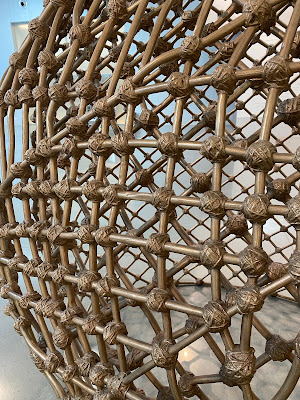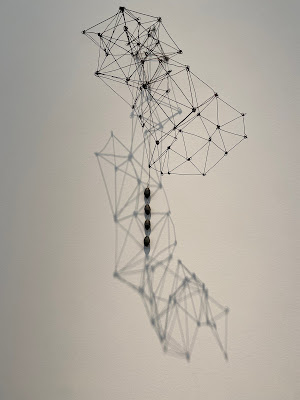I'm just back from a fun few days in Houston at the Contemporary Handweavers Guild of Texas (CHT) conference. I taught two classes, "Using Photos to Design Tapestry" and Sampling: Your Tapestry Superpower. It was great being with so many engaged tapestry people! The keynote speech by Nathalie Miebach was interesting and thought-provoking. As usual, once students entered my classroom I got caught up in the moment and totally forgot to take photos, so sorry about that. What imaginative, curious and welcoming artists!
I was also bowled over by the art on offer in Houston. Sam and I went a couple days early so we could tick off a bucket list item for both of us: the Rothko Chapel.* Photos inside the Chapel are prohibited, so I don't have any to share, but my photos wouldn't do justice to the experience of being in that space anyway. Visitors observed strict silence and indeed several were clearly practicing prayer and meditation. Upon entering from outside, my immediate reaction was disappointment: "Oh, all these panels are the same dull gray. Hmm. I've been misled. Not much to see here."
And then my eyes adjusted to the diffuse light entering through the oculus in the center of the ceiling.
I noticed that in fact each large painted panel was a slightly different color from the others and had subtle color and tonal variations within itself. Violet, dark purple, maroon, dark green, and rich grays and blacks were all present. There were subtle changes in brushstrokes and paint application. And here's the magical thing: the more you looked, the more you saw. And as time passed and the clouds moved in front of the sun outside, the light inside shifted too, and the colors changed subtly. The experience of looking at these massive, overwhelming panels was humbling, fascinating, and definitely inclined me to confront the noisiness of my own mind and to ponder for a few moments the mysteries of perception and even the divine. This is art that throws you back on your own resources and invites slow contemplation.
 |
| Barnett Newman, Broken Obelisk, outside the Rothko Chapel |
The next day we visited the Museum of Fine Arts, Houston, which has a new wing, the Nancy and Rich Kinder Building, devoted to contemporary and modern art. We experienced the Pipilotti Rist video and light installation called Pixel Forest and Worry Will Vanish, which was a 180-degree contrast to the Rothko Chapel: bright, almost overwhelmingly stimulating, art as spectacle for the contemporary audience already saturated with video and color and imagery. Like the Rothko Chapel, the installation was huge and immersive, but it was full of motion and color rather than still and near-monochrome. It was fun to walk through the forest of changing colored lights and be surrounded on two sides by giant video projections of natural forms processes both vegetal and human. It felt magical and very of-the-moment. To my mind, it's perhaps not as enduring as the Rothko Chapel installation--and it may be that temporality and mutability are Rist's main concerns. On second thought, perhaps that is what the two installations have in common after all. . .
For me the art objects I saw in conversation with each other at the MFAH are what I will keep coming back to. I was delighted to find work by two of my favorites, Martin Puryear and El Anatsui, in company with each other, commanding a large space in the new wing. Both use weaving/stitching techniques to assemble powerful objects that invite our imaginative attention. Puryear's work is often rooted in basketry, though his piece here was made of bronze. I loved how the open mesh layers looked from various angles. And behind it, spanning a loooooong curved wall, hung the largest Anatsui "tapestry" I'm aware of, composed of stitched together bottle caps and metallic foil strips in rich folds. Weavers can't help but respond to the way the image grows one "pixel" at a time, in parts becoming what seems to be an urban map, and to be awed by the sheer labor involved. Walking along this piece is akin to taking a journey through a varied landscape.
 | |
| foreground: Martin Puryear, Aso Oke, 2019, edition 2/3, bronze. background: El Anatsui, Untitled, 2020, found aluminum and copper wire |
 |
| detail, Puryear, Aso Oke |
 |
| detail, Anatsui, Untitled |
 |
| detail, Anatsui, Untitled |
I am sort of a museum geek, I admit it. I loved how the curators at this museum assembled and interpreted the work on display. No dry academic marches through chronological art history here, strictly segregated by geography and medium. Artworks from throughout time and space were grouped so they could spark off of each other.
Sam and I spent a lot of time in the Line into Space gallery, where I was delighted to find work by Ruth Asawa and the sensational Gego, currently having a much-talked-about exhibit in New York's Guggenheim Museum. Both have an amazing power to manipulate simple wire into fascinating forms that marry drawing with sculpture. Having recently emerged from a long and tangled rabbit trail trying to crack the code on Asawa's looping technique, it was great to be able to examine her piece up close.
 | |||||
| Ruth Asawa, Untitled (S. 562, Hanging Sphere with Two Cones that Penetrate the Sphere from Top and Bottom), c. 1954, galvanized steel wire and brass wire |
 |
| Gego (Gertrud Goldschmidt), Sin título (Untitled), c. 1987, perforated and painted metal netting |
 |
| Gego, Apliqué de Reticulárea (Reticulárea Wall Appliqué), 1969, iron and stainless-steel wire, nylon, and lead weights |
 | |
| Gego, Vibración en negro (Vibration in Black), 1957, aluminum painted black |
In a few days I leave for a long-postponed two-week tapestry tour of France led by Cresside Collette. I imagine my brain will continue to explode as we see both monuments of medieval tapestry and the studios of contemporary weavers! Stay tuned for more about that in July!
* Interestingly, the main photos on the Rothko Chapel website are in black and white. Even they don't try to capture the colors! It's up to the viewer to come and discern them for herself.
